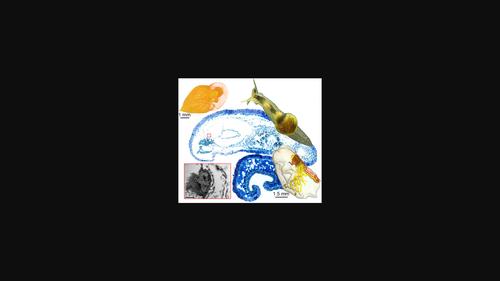当前位置:
X-MOL 学术
›
J. Morphol.
›
论文详情
Our official English website, www.x-mol.net, welcomes your feedback! (Note: you will need to create a separate account there.)
Really a “secondary gill under the skin”? Unveiling “dorsal vessels” in freshwater slugs (Mollusca, Panpulmonata, Acochlidimorpha)
Journal of Morphology ( IF 1.5 ) Pub Date : 2023-10-18 , DOI: 10.1002/jmor.21653 Timea P Neusser 1 , Bastian Brenzinger 2 , Michael Schrödl 1, 2 , Katharina M Jörger 2
Journal of Morphology ( IF 1.5 ) Pub Date : 2023-10-18 , DOI: 10.1002/jmor.21653 Timea P Neusser 1 , Bastian Brenzinger 2 , Michael Schrödl 1, 2 , Katharina M Jörger 2
Affiliation

|
The freshwater slugs of the genus Acochlidium (Heterobranchia, Gastropoda, and Acochlidimorpha) are peculiar, one to two centimeter sized animals found only in small coastal rivers and streams of Southeast Asian and Western Pacific islands. When first described by Bücking, the author observed a branching “net of dendritic vessels connected to the heart,” which he assumed to have replaced the original gastropod gill. In the present study, we compare the renopericardial systems of four Acochlidium species in microanatomical, histological and ultrastructural detail and identify where exactly the enigmatic, subepidermal “dorsal vessels” connect to the renopericardial system to examine if they can really function as a gill. Acochlidium have elaborate renopericardial systems compared to their ancestrally marine and also freshwater relatives. The primary site of ultrafiltration is the epicardium of the atrium with podocytes as usual for gastropods. The “dorsal vessels” in Acochlidium are extensions of the outer epithelium of the pericardial cavity and represent true vessels, that is, coelomatic channels, having an endothelium with podocytes. Hence, they considerably enlarge the site of ultrafiltration increasing the pericardial surface. “Dorsal vessels” in Acochlidium are therefore not homologous to externally similar morphological structures in Sacoglossa (marine panpulmonate slugs and snails). The multiplication of renopericardioducts in Acochlidium is a unique feature within Mollusca that enhances the negative pressure necessary for ultrafiltration in the thin, tube-like dorsal vessels and as a consequence the transport of primary urine from the pericardium to the kidney. The circulatory and excretory systems in Acochlidium are adaptations to a lifestyle in their freshwater environment in which snail bodies are hyposmotic and accrue considerable influx of surplus water into the body, which needs to be expelled.
中文翻译:

真的是“皮下二次鳃”吗?揭开淡水蛞蝓(软体动物、Panpulmonata、Acochlidimorpha)“背部血管”的面纱
Acochlidium属的淡水蛞蝓(异鳃亚纲、腹足纲和Acochlidimorpha)是一种奇特的动物,体型一到两厘米,仅在东南亚和西太平洋岛屿的沿海小河流和溪流中发现。当巴金首次描述时,作者观察到一个分支的“与心脏相连的树突状血管网”,他认为它取代了原来的腹足动物鳃。在本研究中,我们从显微解剖学、组织学和超微结构细节上比较了四种Acochlidium物种的肾包系统,并确定了神秘的表皮下“背血管”与肾包系统的确切连接位置,以检查它们是否真的可以发挥鳃的功能。与它们的祖先海洋和淡水亲戚相比,Acochlidium具有复杂的心包系统。超滤的主要部位是心房的心外膜,与腹足动物一样,具有足细胞。Acochlidium中的“背血管”是心包腔外上皮的延伸,代表真正的血管,即体腔通道,具有带足细胞的内皮。因此,它们大大扩大了超滤部位,增加了心包表面。因此, Acochlidium中的“背侧血管”与 Sacoglossa(海洋全肺蛞蝓和蜗牛)中外部相似的形态结构并不同源。Acochlidium中肾包管的增殖是软体动物中的一个独特特征,它增强了细管状背血管中超滤所需的负压,从而将初级尿液从心包输送到肾脏。Acochlidium的循环和排泄系统是为了适应淡水环境中的生活方式,在淡水环境中,蜗牛的身体处于低渗状态,会积累大量多余的水分进入体内,需要将其排出。
更新日期:2023-10-18
中文翻译:

真的是“皮下二次鳃”吗?揭开淡水蛞蝓(软体动物、Panpulmonata、Acochlidimorpha)“背部血管”的面纱
Acochlidium属的淡水蛞蝓(异鳃亚纲、腹足纲和Acochlidimorpha)是一种奇特的动物,体型一到两厘米,仅在东南亚和西太平洋岛屿的沿海小河流和溪流中发现。当巴金首次描述时,作者观察到一个分支的“与心脏相连的树突状血管网”,他认为它取代了原来的腹足动物鳃。在本研究中,我们从显微解剖学、组织学和超微结构细节上比较了四种Acochlidium物种的肾包系统,并确定了神秘的表皮下“背血管”与肾包系统的确切连接位置,以检查它们是否真的可以发挥鳃的功能。与它们的祖先海洋和淡水亲戚相比,Acochlidium具有复杂的心包系统。超滤的主要部位是心房的心外膜,与腹足动物一样,具有足细胞。Acochlidium中的“背血管”是心包腔外上皮的延伸,代表真正的血管,即体腔通道,具有带足细胞的内皮。因此,它们大大扩大了超滤部位,增加了心包表面。因此, Acochlidium中的“背侧血管”与 Sacoglossa(海洋全肺蛞蝓和蜗牛)中外部相似的形态结构并不同源。Acochlidium中肾包管的增殖是软体动物中的一个独特特征,它增强了细管状背血管中超滤所需的负压,从而将初级尿液从心包输送到肾脏。Acochlidium的循环和排泄系统是为了适应淡水环境中的生活方式,在淡水环境中,蜗牛的身体处于低渗状态,会积累大量多余的水分进入体内,需要将其排出。



























 京公网安备 11010802027423号
京公网安备 11010802027423号